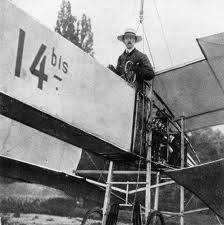In the last post –Brazil as natural future economy – I promised to observe Brazil from different perspectives. To respect the tradition of evolutionary economics, in this post I investigate Brazilian innovation from first aeroplane flight in 1906 to Innovation Law established in 2004. This period highlights the Brazilian potential for innovation and how it missed almost a century on global development caused by the lack of strategic approach to innovation. The Story of Science clearly states that innovations does not happen over the night and requires balance between passion for science and research, political power, and open global collaboration and rivalry as Michael J. Mosley shows in my favourite documentary!
 Brazil gained the independence from Portugal in 1822. Portugal legacy left Brazil underdeveloped as country had been mainly used as a source for raw materials to feed the parent country. There was no investment on education system, universities or scientific organizations. Many international and internal conflicts kept Brazil underdevelopment for many decades. Only innovation policy highlight comes from establishment of Instituto Butantan biomedical research center to Sao Paulo in 1901 and innovation highlight from year 1906: If you went to European or North American school you most probably have learned that the Wright Brothers invented and flew the first aeroplane in 1903. However if you look on Brazilian school books you can find that first actual flight with “real” airplane was made by Alberto Santos Dumont with 14-bis aeroplane in 1906. This is a many times praised as one of the global achievements of innovation in Brazil. Brazilian basic education, university and science and research system remained relatively underdeveloped until 1930s.
Brazil gained the independence from Portugal in 1822. Portugal legacy left Brazil underdeveloped as country had been mainly used as a source for raw materials to feed the parent country. There was no investment on education system, universities or scientific organizations. Many international and internal conflicts kept Brazil underdevelopment for many decades. Only innovation policy highlight comes from establishment of Instituto Butantan biomedical research center to Sao Paulo in 1901 and innovation highlight from year 1906: If you went to European or North American school you most probably have learned that the Wright Brothers invented and flew the first aeroplane in 1903. However if you look on Brazilian school books you can find that first actual flight with “real” airplane was made by Alberto Santos Dumont with 14-bis aeroplane in 1906. This is a many times praised as one of the global achievements of innovation in Brazil. Brazilian basic education, university and science and research system remained relatively underdeveloped until 1930s.
Brazilian recent po litical history can be divided to three phases based on Rosanis (2011) dissertation on Brazilian innovation system. 1930 – 1980 is named as “state-led protective industrialization” or “milagre econômico brasileiro”. Protectionist policies contributed to high GDB growth and high levels of local industrial expansion. The policies culminate on Singer-Prebisch thesis in 1950, dependency theory and import substitution industrialization which aimed to decrease dependency from Western developed economies and increase local production. However, these policies missed the fact that only selected industries should be protected. In addition, these policies produced disincentives to innovation, decreased rates of productivity and lead technological inefficiency. Innovation policy highlighst for this period were establishment of Aeronautic Technological Institute (ITA) in 1950, the National Research Council (CNPq) in 1951, the Brazilian Development Bank (BNDE) in 1953, the Agency for Financing studies and Projects (FINEP) in 1965, and the Brazilian Agricultural Research Corporation (Embrapa) in 1973. Apparently, these instruments did not get much attention among policy makers from strategic innovation perspective, and science and research remained marginal and isolated. One of the reasons for this was the misleading assumption made in Latin American World model in 1970s. It assumed that most important modern world challenges were not scientific but social and political. This lead to state that
litical history can be divided to three phases based on Rosanis (2011) dissertation on Brazilian innovation system. 1930 – 1980 is named as “state-led protective industrialization” or “milagre econômico brasileiro”. Protectionist policies contributed to high GDB growth and high levels of local industrial expansion. The policies culminate on Singer-Prebisch thesis in 1950, dependency theory and import substitution industrialization which aimed to decrease dependency from Western developed economies and increase local production. However, these policies missed the fact that only selected industries should be protected. In addition, these policies produced disincentives to innovation, decreased rates of productivity and lead technological inefficiency. Innovation policy highlighst for this period were establishment of Aeronautic Technological Institute (ITA) in 1950, the National Research Council (CNPq) in 1951, the Brazilian Development Bank (BNDE) in 1953, the Agency for Financing studies and Projects (FINEP) in 1965, and the Brazilian Agricultural Research Corporation (Embrapa) in 1973. Apparently, these instruments did not get much attention among policy makers from strategic innovation perspective, and science and research remained marginal and isolated. One of the reasons for this was the misleading assumption made in Latin American World model in 1970s. It assumed that most important modern world challenges were not scientific but social and political. This lead to state that
During this period, Brazil emerged as supplier of raw materials and crops and increased its capacity in manufacturing industry. Still in short, Brazil and other Latin American countries missed the one of the highest technological development phases in human history. Efforts to decrease the dependency to Western economies actually laid a ground for technological dependency for coming decades when global scale economic liberalization took place.
This lead to the Bra zilian lost decades in 1980 – 2000. During this period Brazil as other Latin American countries’ economic development stagnated, poverty increased and income distribution gap increased. Recovery policies failed and increased the foreign dept. All this lead to super inflation and drew Brazil to economic and social turmoil.
zilian lost decades in 1980 – 2000. During this period Brazil as other Latin American countries’ economic development stagnated, poverty increased and income distribution gap increased. Recovery policies failed and increased the foreign dept. All this lead to super inflation and drew Brazil to economic and social turmoil.
In 1985 the Brazilian Ministry of Science and Technology (MCT) was formed to implement national innovation policies. However, investments to science and research does not realize overnight and didn’t help much Brazilian innovation performance during the economic and social difficulties. While Finland and South Korea as well as many other historically underdeveloped countries entered to global liberalization in 1990s with high technological capacity, Brazil and other Latin American countries were forced to rely even more heavily on foreign technologies to catch-up modern development. The Real Plan, Foreign Trade Policy (PICE) and the National Privatization Program (PND) meant Brazilian companies needed to enter global competition in 1990s. One only need look situation in sales of 50 biggest companies in Brazil in 2000 to figure out what happened. 19 out of 50 biggest companies in 2000 in Brazil were foreign owned and especially if we look high-tech industries as automobiles (9/10), telecommunications (5/10), petro chemistry (4/10), Information and communication technologies (8/10), pharmaceutics (8/10), and electronics (9/10) were foreign owned.
 Stefan Zweig wrote already in 1941 “Brazil: Land of the Future”. In following decades this already became a joke arguing that “Brazil is the country of tomorrow – and always will be!” However, when coming to new millennium Brazil is finally starting to fulfil its promises.
Stefan Zweig wrote already in 1941 “Brazil: Land of the Future”. In following decades this already became a joke arguing that “Brazil is the country of tomorrow – and always will be!” However, when coming to new millennium Brazil is finally starting to fulfil its promises.
Macroeconomic stability gained in late 1990s, President Lula’s social and international policies etc. as stated in earlier post – Brazil as natural future economy – have increased the arguments that Brazil is finally becoming a serious country not only famous of football, carnival and bikinis.
In 2005 almost century later of Santos Dumont first flight, Brazilian company Empresa Brasileira de Aeronáutica (EMBRAER) made again historical mark for aviation history. They unveiled the Ipanema, the first commercially produced aircraft to run solely on biofuels. This was not cause of blind change! One policy act still not mentioned in this post is the PróAlcool bioethanol policy implemented in 1975 to response the 1973 oil crises. Historical and long term evolutionary understanding of global development matters!
 The Story of Brazilian Science is much more fascinating that one might think. This blog post shows that Brazilian innovation culture has deeper historical roots than many can image and lack of policy understanding for innovation have kept this part of the Brazil hidden for decades. Now it is time for Brazil to show its real face on race to tackle global societal challenges such as climate change and poverty reduction. All this culminates to Innovation Law established in 2004 which my next blog post will tackle.
The Story of Brazilian Science is much more fascinating that one might think. This blog post shows that Brazilian innovation culture has deeper historical roots than many can image and lack of policy understanding for innovation have kept this part of the Brazil hidden for decades. Now it is time for Brazil to show its real face on race to tackle global societal challenges such as climate change and poverty reduction. All this culminates to Innovation Law established in 2004 which my next blog post will tackle.
If you liked it please share this below on Facebook, Twitter, Linkedin or mail this to people interested on Brazil and if you want to contribute on our knowledge on Brazil please comment on this 😉